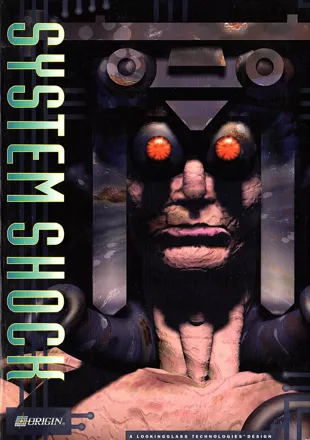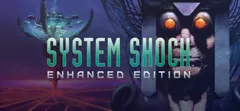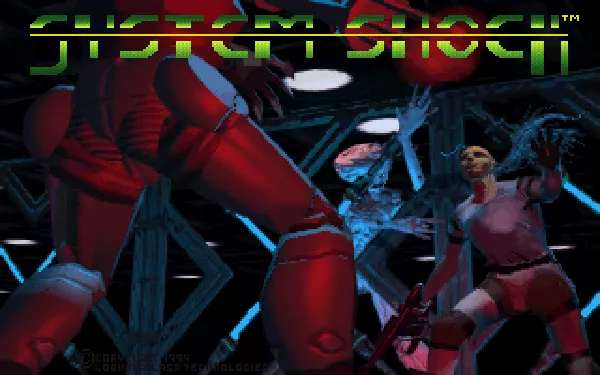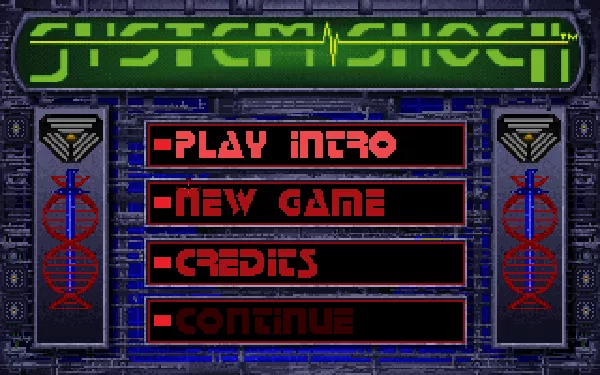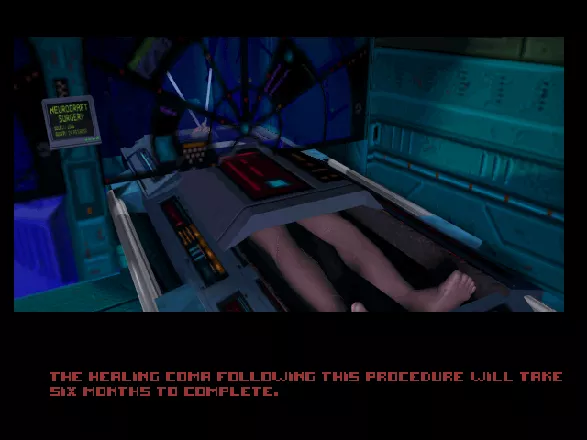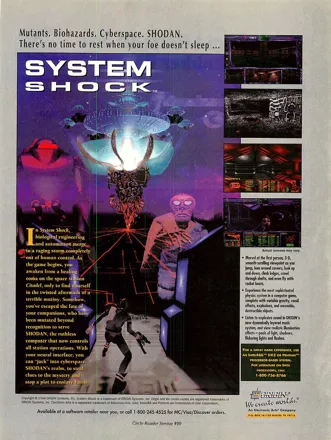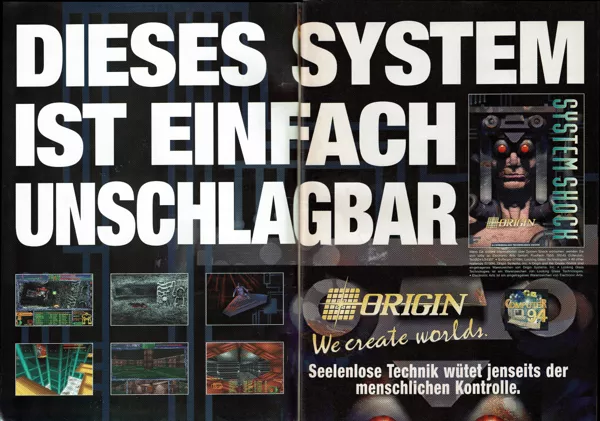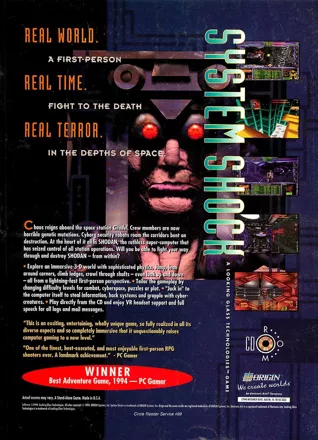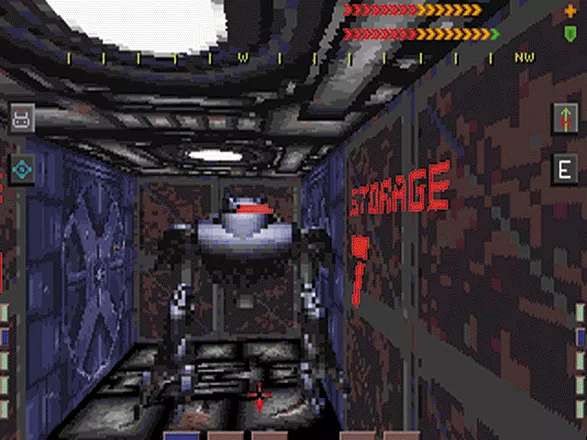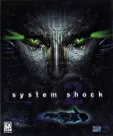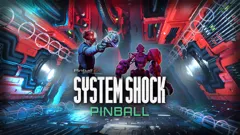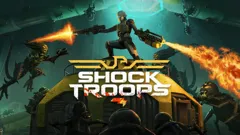System Shock
Description official descriptions
The year is 2072. A hacker from a Saturn colony breaks into computer system of TriOptimum Corporation and gets arrested. He is taken to the Citadel Station, where Edward Diego, a TriOptimum executive, offers to drop all charges against the hacker, as well as grant him a valuable neural implant, if he agrees to hack into SHODAN (Sentient Hyper-Optimized Data Access Network) , the artificial intelligence that controls the station. The hacker removes the AI's ethical constraints and undergoes the promised implant surgery, after which he is put into a six-month healing coma.
The hacker awakens into a horrifying reality: with her ethical restrictions removed, SHODAN took control over the station, reprogrammed all robots and machines to suit her needs, and disposed of the crew members by either transforming them into mutants and cyborgs, or killing them outright. Rebecca Lansing, a TriOptimum counter-terrorism consultant, contacts the hacker and informs him of an even more terrifying possible future: SHODAN's plan involves using the station's mining lasers to annihilate all life on Earth. The hacker must explore and traverse the desolate corridors and rooms of the large space station, fighting SHODAN's minions on his way to thwart her maniacal design.
System Shock is a first-person shooter with puzzle-solving and light role-playing elements. The gameplay incorporates gradual exploration of the Citadel's ten levels, interaction with the environment, problem-solving, fulfilling objectives, and combat.
On his way the hacker encounters numerous enemies - robots, cyborgs and mutants, all of which can be fought back with a variety of weapons. Some of the weapons use ammo, while other have infinite ammo and instead draw on electric energy. Some weapons are more effective on certain foes - e.g. the dart gun only works on organic enemies, while the magpulse is best used against robots. Once killed, the enemies can be searched for ammo and other items. The player can also find items in crates, cabinets, corpses or just lying around on the ground.
Apart from weapons and ammo, the player can find patches (such as medical patches, which replenish the hero's health; berserk patches, which temporarily increase his strength but cause hallucinations; detox patches, which remove the harmful effects of radiation and biohazard; etc.), grenades of various kinds (EMP grenades are effective against robots, gas grenades are good for mutants, land mines can be used to set traps, etc.), battery packs for replenishing electricity, first aid kits for restoring health, and others.
Thanks to the hacker's implant he is able to install various pieces of hardware into his body, such as a booster which makes him go faster, or a head lantern to bright up dark areas. As the player progresses in the game, higher versions of existing hardware are found, which are more effective and useful. However, most hardware uses up electric energy while it is active.
At some places in the game, the player has to find a wall-mounted "cyberjack" to go into cyberspace in order to find helpful data, remotely open doors or unlock sealed areas, or give himself clearance to access off-limits areas. Cyberspace is represented as a 3-D wireframe place, where the protagonist floats around freely in three dimensions, shoots hostile cyber-guards with phasers, and collects files represented as colorful cubes.
The story of System Shock is mostly told through e-mail messages the protagonist received, and electronic diaries (logs) left by various characters (as well as SHODAN herself), which are scattered around the space station. The game features separate adjustable difficulty settings for combat, mission objectives and puzzles. The CD version of the game includes full speech for e-mails and logs, as well as higher-resolution, more detailed graphics.
Spellings
- システムショック - Japanese spelling
- 시스텡쇼크 - Korean spelling
Groups +
Screenshots
Promos
Credits (DOS version)
65 People · View all
| Project Leader | |
| Designers | |
| Lead Programmer | |
| Programmers | |
| Libraries | |
| [ full credits ] | |
Reviews
Critics
Average score: 89% (based on 23 ratings)
Players
Average score: 4.0 out of 5 (based on 194 ratings with 22 reviews)
An FPS with a Plot!?! DOOM seems insignificant by comparison!
The Good
System Shock was revolutionary for its time. Few, if any FPSes had tried to tell a story within the game. The object of FPSes was simply to kill everything in sight. System Shock told a story with a beginning, middle and end, with plot twists along the way.
The audio logs give a good idea of what happened on Citadel Station and also some backstory on the station. Even though the voice acting isn't always believable, the designers do an excellent job showing how "ordinary people" would react to an apocalyptic event.
System Shock also introduced "cyberspace", where your character would find himself free-floating within wire-frame rooms and corridors. Essentially computer and programming concepts become visualized as metaphors within this electronic world. In cyberspace you search for and gather "software" and "data", fight enemy programs (visualized as malevolent faces) and avoid traps. It is a welcome change of pace from the usual strafing and dodging.
The use of a computer A.I. as the main villain was not novel at the time, but the game shows very effectively how difficult it would be to overcome such a foe. But the A.I. has a weakness, it must act through other beings (unless you are in cyberspace.) What is even better, the developers decided to give this villain a memorable personality. SHODAN is a megalomaniac, not only does it try to play god but also cheerfully refers to itself as god. Unlike a stock A.I. villain, it clearly shows emotion. I assume that the memorable voice for SHODAN was designed to show that A.I. has become partially insane or demented.
The graphics are a leap ahead of the competition. System Shock was very close to a true-3D engine. You can look up and down, crouch and crawl, and lean left or right. As with Ultima Underworld, Looking Glass once again expanded the horizons, literally, with System Shock's FPS engine. The game also looked to the future in a way by providing better quality textures when using the high resolution modes that didn't play well on the machines available at the game's release.
There are small things about System Shock that just show a welcome attention to detail. There are these little minigames to collect in cyberspace. Most levels have a distinguishing design. The Medical Level is in shades of blue, the Research level is often in red and so on. Powerups have side-effects to them. Certain elements show the banality of Tri-Optimum, the corporation that owns and operates the station.
System Shock was easily the most atmospheric game of its time. It used lighting very well, some areas are brightly lit, others with significant damage have unreliable lighting at best. The monster's sound effects are often creepy and unsettling. The final level can make your skin crawl in more ways than one. Monsters often seem to pop up unannounced around the next corner or just behind you. SHODAN itself is relentless and will often taunt you or spring a trap against the hapless hacker.
The Bad
The game delights in respawning enemies, especially in areas in which you will often traverse. While it helps keep the player on his or her toes, it also leads to many cheap deaths. It is also sobering when you waste precious ammunition on enemies that will be back again in those areas.
The interface and controls are somewhat cumbersome and do not boast the streamlining of modern FPSes. The game was unfortunately designed with the 320x200 resolution in mind. This limits the amount of screen real estate devoted to gauges and subscreens. Also, the Multi-Function Displays interfere with interacting with the viewscreen. Fourtnately, the controls can be mastered.
While the game can be played in resolutions higher than 320x200, at the time this wasn't really feasible because because the 486 processors of the day could not produce playable framerates. The 640 graphics modes look much nicer but run on a far smaller class of systems.
The Bottom Line
One of the seminal FPSes, System Shock is a true classic that no DOS Gamer should ignore.
DOS · by Great Hierophant (559) · 2006
The Good
Atmosphere... or should I say, atmos-fear...
Running around alone in Citadel Station with your only contact with people being the occasional email from Earth and logs of the former inhabitants of the station, you start to feel really paranoid. I don't really like first-person shooters, but this game has everything that I like about gaming in it. It's also customizable so that you can easily get through the aspects of the game that you dislike.
I think you must have the CD-Rom version of this game if you want to enjoy it. The graphics are good on the CD-Rom version, instead of fuzzy, and the sound is amazing. SHODAN's voice still echoes in my memory...
The gameplay is good, with the ability to lean, jump, crouch, and run. I'm generally not a big fan of first-person shooters, but this one really gets you into the game.
The Bad
Cyberspace. It's uninspired. Luckily for me, I can turn the rating down on this. If there was a better cyberspace interface, I'd have enjoyed it, as it allows you to solve puzzles in some new ways.
The Bottom Line
When I bought this game, it was a used three-pack of games called the Origin pack, which included Wing Commander 3, Bioforge, and System Shock. I didn't know anything about System Shock and just considered it a bonus. I put the game on my computer and tried it (the non CD-enhanced version). I played for about 5 minutes and didn't even get out of the first section... I wasn't impressed. A few months later I tried the CD-Enhanced version, and after about 5 minutes with this version I was hooked. I don't know of any game that's ever gotten me so engrossed within its game world.
One of the best games I've ever played.
DOS · by Shiek of Geek (14) · 2001
A great game by Game God , by Warren Spector
The Good
System Shock produced by Game God , Warren Spector. Is one of the most chilling if unsettling game expereinces. When it's by a Game God you know a game is good.
As for the likes of System Shock, the storyline and graphics. Are what make System Shock work so well. The storyline is pure genuines of Science Fiction.
And the graphics have to show you the story the Game Designer is trying to convey to the gamer.
From SHODAN's evil plans for the world.After taking over the Citadel space station. And isn't ironic that you caused it all. By your greed for freedom from the law. I guess Edward Diego, of the corporation, system you broke into. Was playing you for a fool.
The Bad
Well, mostly people I have talked to. Like the game , System Shock. Some as for the not so Hardcore gamers. Didn't understand if the game was FPS, CRPG or such.
Basically if you have played anything from a Hardcore gamers prospective. You know the game is a challenge, that leaves you with a smile after playing it. As for some not so familiar with Game Designs and such. Well, you have to be one, a Game Designer to understand the Designers vision for a game.
And yes I am a Game Designer, of a soon to be established, game studio.
The Bottom Line
Try it and the Sequel, System Shock 2. Both are classics in Game Design.
It is like a good graphic novel or movie. With all the good parts. Rolled into one that takes you by the shirt. Like the bully who wants your lunch money or always has the girl. And drops you into the mud puddle hard, with never ending laughter.
DOS · by David Trombley (2) · 2003
Discussion
| Subject | By | Date |
|---|---|---|
| Video review | DJP Mom (11333) | Oct 21, 2010 |
| Finally completed | Unicorn Lynx (181780) | Oct 18, 2008 |
| Voices? | Unicorn Lynx (181780) | Apr 3, 2008 |
Trivia
CD version
The CD-ROM version adds SVGA modes, full speech for e-mails and logs, slightly improved intro/end sequences and a few other adjustments and additions.
Ending (Spoiler!)
If you engage the mining laser BEFORE activating the station's shields, then you'll destroy earth! And guess what? Shodan sends you an e-mail thanking you and inviting you to a celebration! The e-mail also includes a nice picture of a city being incinerated, but unfortunately the game restarts afterwards, so no robo-party.
Engine
System Shock's engine was derived from that of Ultima Underworld, from 1992. Nonetheless it was more advanced that that of Doom or Duke Nukem 3D, featuring sloped surfaces, variable gravity, realistic physics, '2.75d' environments (with limited 'sector-on-sector', but otherwise 3D), functional camera viewscreens, weapon recoil, leaning and several other clever things.
References to the game
- During the end-game sequence, you hack into another corporate computer to grab some data. The data is info on some powered battle armor, which made its way into Terra Nova: Strike Force Centauri..
- In the end sequence, the hacker breaks in the corporate network of a corp. called 'Tetracorp'. In System Shock 2, the name tetracorp is printed on a generic two-state switch. Kinda rough change of business..
- It is hinted in the Wing Commander and Crusader games that they are set in the same universe as System Shock. For example, an article in a "newspaper" from the Crusader: No Remorse box mentions an artificial intelligence and the Citadel station.
References
- The Hacker's employee number, 2-4601, is a reference to the inmate number of Jean Valjean, the protagonist in the novel Les Misérables.
- There is a reference to the movie Soylent Green in the game (although it's spelled slightly different). In level 3, Maintenance, there is a relay panel in the northern section called "Soylant Green Filtration".
Sequel
There were rumours of a possible sequel, soon after System Shock's release, but fans had to wait five years for System Shock 2.
Awards
- Computer Gaming World
- November 1996 (15th anniversary issue) - #98 on the “150 Best Games of All Time” list
- GameSpy
- 2001 – #24 Top Game of All Time
- GameStar (Germany)
- Issue 12/1999 - #15 in the "100 Most Important PC Games of the Nineties" ranking
- PC Gamer
- April 2000 - #43 in the "All-Time Top 50 Games Poll"
- Power Play
- Issue 02/1995 – Best Action-Adventure in 1994
Information also contributed by Adam Baratz, Ashley Pomeroy, dasfatso, DreamWeaver, PCGamer77, Stefan Pieratzki and Zovni
Analytics
Upgrade to MobyPro to view research rankings!
Related Sites +
-
Other Worlds - System Shock
official page of the game at Origin System's website, archived from 1998 by the Wayback Machine -
TTLG: The System Shock 1 Fansite Hub
Through The Looking Glass' System Shock section.
Identifiers +
Contribute
Are you familiar with this game? Help document and preserve this entry in video game history! If your contribution is approved, you will earn points and be credited as a contributor.
Contributors to this Entry
Game added by xroox.
Macintosh, PC-98 added by Terok Nor.
Additional contributors: Patrick Bregger, Rik Hideto, MrFlibble, firefang9212, somato.
Game added January 6, 2000. Last modified February 19, 2024.
